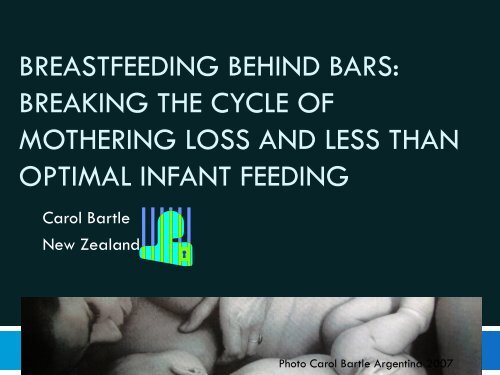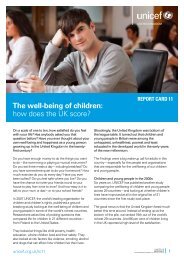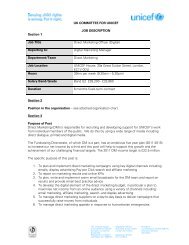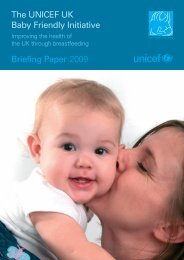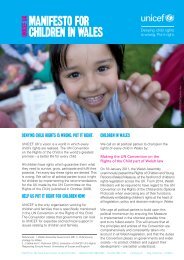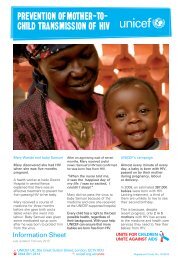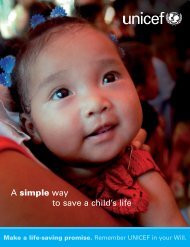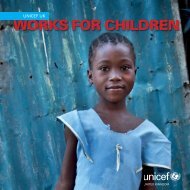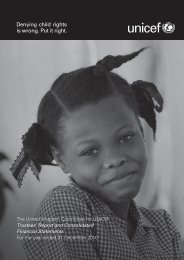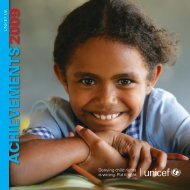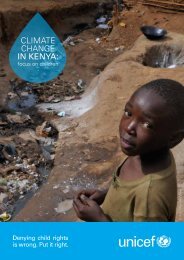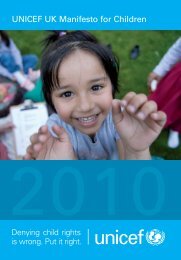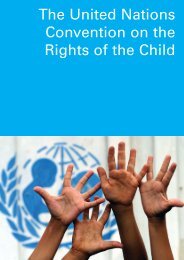Breastfeeding Behind Bars: Breaking the cycle of ... - Unicef UK
Breastfeeding Behind Bars: Breaking the cycle of ... - Unicef UK
Breastfeeding Behind Bars: Breaking the cycle of ... - Unicef UK
Create successful ePaper yourself
Turn your PDF publications into a flip-book with our unique Google optimized e-Paper software.
BREASTFEEDING BEHIND BARS:<br />
BREAKING THE CYCLE OF<br />
MOTHERING LOSS AND LESS THAN<br />
OPTIMAL INFANT FEEDING<br />
Carol Bartle<br />
New Zealand<br />
Photo Carol Bartle Argentina 2007
Mo<strong>the</strong>rs and Babies <strong>Behind</strong> <strong>Bars</strong> – Nursery<br />
Programmes<br />
‣ Provide secure housing spaces within correctional<br />
facilities where incarcerated women can stay with<br />
<strong>the</strong>ir babies<br />
‣ Women complete <strong>the</strong>ir sentences while being <strong>the</strong><br />
primary caregiver<br />
‣ Aim to establish a foundation that protects future<br />
child development<br />
(Byrne, Goshin & Blanchard-Lewis 2012)
A Human Rights Framework<br />
Universal Declaration <strong>of</strong> Human Rights<br />
Article 16:3<br />
‣The family is <strong>the</strong> natural and fundamental<br />
group unit <strong>of</strong> society and is entitled to<br />
protection by society and <strong>the</strong> state<br />
Article 25:2<br />
‣Mo<strong>the</strong>rhood and childhood are entitled to<br />
special care and assistance
International Covenant on Economic, Social<br />
and Cultural Rights<br />
Article 10:2<br />
‣ Special protection for mo<strong>the</strong>rs during a<br />
reasonable period before and after childbirth<br />
Article 10:3<br />
‣ Special measures <strong>of</strong> protection and assistance<br />
should be taken on behalf <strong>of</strong> all children
International Covenant on Economic, Social<br />
and Cultural Rights<br />
Article 12<br />
‣ The rights to <strong>the</strong> highest attainable standard <strong>of</strong><br />
physical and mental health. The provision for<br />
<strong>the</strong> healthy development <strong>of</strong> <strong>the</strong> child
Convention on <strong>the</strong> elimination <strong>of</strong><br />
discrimination against women<br />
Article 12<br />
‣States Parties shall ensure to women appropriate<br />
services in connection with pregnancy, confinement<br />
and <strong>the</strong> post-natal period, granting free services<br />
where necessary, as well as adequate nutrition<br />
during pregnancy and lactation
United Nations Convention on <strong>the</strong> Rights <strong>of</strong> <strong>the</strong><br />
Child<br />
54 articles<br />
Provision rights<br />
‣ Minimum standards <strong>of</strong> family life and access to<br />
parental care, health, education, physical care,<br />
play, recreation, culture and leisure<br />
‣ This covers <strong>the</strong> rights <strong>of</strong> children with parents in<br />
prison to have contact
United Nations Convention on <strong>the</strong> Rights <strong>of</strong><br />
<strong>the</strong> Child<br />
Preamble<br />
‣ Childhood is entitled to special care and assistance<br />
‣ Recognises that children are living in difficult<br />
conditions globally<br />
Article 3<br />
‣ The best interests <strong>of</strong> <strong>the</strong> child shall be <strong>the</strong> primary<br />
consideration
United Nations Convention on <strong>the</strong> Rights <strong>of</strong><br />
<strong>the</strong> Child<br />
Article 6<br />
‣ State parties shall ensure to <strong>the</strong> maximum extent<br />
possible <strong>the</strong> survival and development <strong>of</strong> <strong>the</strong> child<br />
Article 24<br />
‣ The rights <strong>of</strong> <strong>the</strong> child to <strong>the</strong> enjoyment <strong>of</strong> <strong>the</strong><br />
highest attainable standard <strong>of</strong> health
United Nations Convention on <strong>the</strong> Rights <strong>of</strong><br />
<strong>the</strong> Child: Article 2<br />
‣ All rights apply to all children without<br />
exception<br />
‣ It is <strong>the</strong> State's obligation to protect children<br />
from any form <strong>of</strong> discrimination and to take<br />
positive action to promote <strong>the</strong>ir rights
United Nations Convention on <strong>the</strong> Rights <strong>of</strong><br />
<strong>the</strong> Child: Article 2<br />
‣ States Parties shall respect <strong>the</strong> right <strong>of</strong> <strong>the</strong> child<br />
who is separated from one or both parents to<br />
maintain personal relations and direct contact<br />
with both parents on a regular basis, except if it<br />
is contrary to <strong>the</strong> child's best interests
United Nations Convention on <strong>the</strong> Rights <strong>of</strong><br />
<strong>the</strong> Child: Article 9<br />
‣<br />
The child has a right to live with his or her parents<br />
unless this is deemed to be incompatible with <strong>the</strong><br />
child's best interests<br />
‣<br />
The child also has <strong>the</strong> right to maintain contact with<br />
both parents if separated from one or both
<strong>Breastfeeding</strong> and feeding rights<br />
1. Infants have <strong>the</strong> right to be free from hunger,<br />
and to enjoy <strong>the</strong> highest attainable standard <strong>of</strong><br />
health<br />
2. Infants are entitled to good food, good health<br />
services, and good care<br />
3. Mo<strong>the</strong>rs have a right to breastfeed<br />
4. Infants have <strong>the</strong> right to be breastfed if <strong>the</strong>ir<br />
mo<strong>the</strong>rs choose to breastfeed<br />
5. George Kent
Mo<strong>the</strong>r-Baby Nursery Programmes<br />
NEBRASKA NURSERY PROGRAMME<br />
Main Goals are to:<br />
‣ Provide opportunity for bonding between <strong>the</strong><br />
inmate mo<strong>the</strong>r and her infant from birth until<br />
approx 18 months <strong>of</strong> age<br />
‣ Facilitate <strong>the</strong> change <strong>of</strong> <strong>the</strong> inmate mo<strong>the</strong>r to a<br />
responsible parent
NEBRASKA NURSERY PROGRAMME<br />
‣ Aid in <strong>the</strong> development <strong>of</strong> realistic expectations<br />
<strong>the</strong> inmate mo<strong>the</strong>r has for herself and her infant<br />
‣ Provide for prenatal and infant health<br />
‣ Provide intervention in breaking <strong>the</strong> <strong>cycle</strong> <strong>of</strong><br />
generational abuse and incarceration
NEBRASKA NURSERY PROGRAMME<br />
‣ Providing prenatal parenting education, infant<br />
care and development education, developing and<br />
coordinating community resources available to <strong>the</strong><br />
mo<strong>the</strong>r during incarceration and on release<br />
‣ Hoped for results include reduced recidivism and<br />
decrease in child abuse and neglect
Photo – Credit Libby Robins, New Zealand<br />
Used with permission
Principles guiding <strong>the</strong> establishment <strong>of</strong><br />
Mo<strong>the</strong>r/baby Units in <strong>the</strong> <strong>UK</strong><br />
‣ To enable <strong>the</strong> mo<strong>the</strong>r/baby relationship to<br />
develop whilst safeguarding and promoting <strong>the</strong><br />
child’s welfare<br />
‣ The best interests <strong>of</strong> <strong>the</strong> child is <strong>the</strong> primary<br />
consideration at every level <strong>of</strong> policy making as<br />
well as when considering individual situations
Principles guiding <strong>the</strong> establishment <strong>of</strong><br />
Mo<strong>the</strong>r/baby Units in <strong>the</strong> <strong>UK</strong><br />
‣ The environment where infants are accommodated<br />
should be designed to meet <strong>the</strong>ir needs<br />
‣ <strong>Breastfeeding</strong> has significant benefits for both<br />
mo<strong>the</strong>r and child and it should be encouraged<br />
and facilitated
Identified barriers to mo<strong>the</strong>r-infant contact<br />
‣ Geographical location<br />
‣ Inability to afford transport<br />
‣ Unwillingness <strong>of</strong> caregivers to transport infants<br />
‣ Inhospitable visiting rooms<br />
‣ Parent reluctance for contact<br />
Seymour, C. Children with parents in prison: Child<br />
Welfare Policy, Program and Practice Issues
Infants and children outside <strong>the</strong> prison<br />
‣ Often experience multiple caregivers<br />
‣ Erratic care giving<br />
‣ Disrupted placements<br />
‣ Loss <strong>of</strong> mo<strong>the</strong>ring and breastfeeding<br />
‣ Reintegration is likely so this causes fur<strong>the</strong>r<br />
disruption
Infant attachment<br />
‣ Secure infant attachment may be facilitated by<br />
participating in a prison nursery programme<br />
‣ Concern that mo<strong>the</strong>rs with background <strong>of</strong><br />
disorganised attachment <strong>the</strong>mselves will be<br />
incapable <strong>of</strong> providing <strong>the</strong> scaffolding necessary to<br />
support secure attachment in <strong>the</strong>ir infants – despite<br />
good intentions
So what could positively contribute to <strong>the</strong><br />
development <strong>of</strong> secure attachment?<br />
‣ Alternatives to incarceration whenever possible<br />
‣ Non –separation <strong>of</strong> mo<strong>the</strong>r and baby<br />
‣ Well supported and appropriate nursery –<br />
mo<strong>the</strong>r/baby programmes – that continue postrelease<br />
‣ <strong>Breastfeeding</strong> protection, promotion and support
‣ Prison Nursery Programmes aim to prevent separation<br />
<strong>of</strong> mo<strong>the</strong>r and baby, allow maternal bonding in ways<br />
that are impossible through visitation and prepare <strong>the</strong><br />
inmate mo<strong>the</strong>r to fulfil parental obligations when she<br />
is released<br />
‣ Participation in PNPs – can reduce criminal behaviour<br />
and be cost saving<br />
Gilad & Gat, The Invisible Victims (2012)
‣ Lower rates <strong>of</strong> recidivism<br />
(Kaufmann 2006)<br />
‣ Preservation <strong>of</strong> <strong>the</strong> mo<strong>the</strong>r-child bond and<br />
emotional and financial costs <strong>of</strong> foster care<br />
avoided<br />
(Goshin & Byrne 2009)
Oxytocin<br />
‣ Oxytocin is present at significantly elevated levels<br />
in women around childbirth and during<br />
breastfeeding<br />
(Macdonald & Macdonald 2010)
Oxytocin<br />
‣ Associated with social behaviours<br />
‣ Oxytocin appears to increase trust and social<br />
interaction and reduces response to social stress -<br />
reduced levels <strong>of</strong> anxiety<br />
‣ Stimulates maternal interaction and attachment<br />
Uvnas-Moberg et al 2001 Applied Animal Behavior Science
Oxytocin<br />
‣ Increasing <strong>the</strong> expression <strong>of</strong> oxytocin receptors<br />
enhances maternal care behaviour in rodents<br />
(Francis et al 2000)<br />
‣ The same process- enhanced oxytocin activity- may<br />
play a part in human <strong>of</strong>fspring's attachment feelings<br />
toward <strong>the</strong>ir parents<br />
(Gordon et al 2008)
Mentalization<br />
‣ The fundamental human capacity to understand<br />
behaviour in relation to mental states such as<br />
thoughts and feelings – capacity to understand<br />
<strong>the</strong> baby’s needs and communications<br />
‣ This is <strong>the</strong> basis <strong>of</strong> healthy relationships and selfawareness
Mentalization - and oxytocin<br />
‣ Oxytocin appears to perform a mediating function<br />
between mentalization and attachment<br />
(Heinrichs & Domes 2008)<br />
‣ “A rapidly accumulating body <strong>of</strong> empirical findings<br />
has suggested that oxytocin specifically improves<br />
performance in mentalizing tasks”<br />
(Domes et al 2008; Guastella, Mitchell, Dadds 2008)
Mentalization – oxytocin and breastfeeding<br />
‣ Women who are breastfeeding appear to be less<br />
physiologically reactive to stress, which may be<br />
accounted for by <strong>the</strong> stimulation <strong>of</strong> <strong>the</strong> nipple as<br />
well as <strong>the</strong> close social contact, both <strong>of</strong> which<br />
increase oxytocin release<br />
(Amico, Johnson & Vagnucci 1994)
v<br />
Mentalization – oxytocin and breastfeeding<br />
‣ Increased resilience to stress may account for <strong>the</strong><br />
epidemiologic observation <strong>of</strong> reduced likelihood<br />
<strong>of</strong> child maltreatment in mo<strong>the</strong>rs who breastfeed<br />
(Stra<strong>the</strong>arn, Mamun, Najman & O’Callaghan 2009)
Mentalization – oxytocin - mo<strong>the</strong>ring<br />
‣ Oxytocin’s mentalization-enhancing function<br />
presents a powerful opportunity for <strong>the</strong> mo<strong>the</strong>r to<br />
optimize her understanding <strong>of</strong> and focus on <strong>the</strong><br />
mental state <strong>of</strong> her infant by close observation <strong>of</strong><br />
<strong>the</strong> infant's expression<br />
(Fonagy, Luyten & Stra<strong>the</strong>arn 2011)
Mentalization – oxytocin - mo<strong>the</strong>ring<br />
‣ Oxytocin concentrations during early pregnancy and<br />
during <strong>the</strong> postpartum period are strongly associated<br />
with maternal bonding as suggested by indicators such<br />
as positive affect, gaze, affectionate touch, and<br />
frequency <strong>of</strong> monitoring <strong>the</strong> infant as well as thoughts<br />
related to attachment<br />
Feldman, Weller, Zagoory-Sharon, and Levine (2007)
“I cannot think <strong>of</strong> a more important relationship<br />
than a mo<strong>the</strong>r and child. Being a mo<strong>the</strong>r takes<br />
whatever selfish motives you have as a person<br />
away and forces you to realise <strong>the</strong>re are much<br />
greater things to invest in …”<br />
Quote from a Correctional Unit Supervisor in <strong>the</strong> US<br />
From L Robins, Mo<strong>the</strong>r and Baby Prison Units (2012)
The importance <strong>of</strong> mo<strong>the</strong>rs – proximity &<br />
contact<br />
‣ Maternal milk, touch, smell, body heat and<br />
biological rhythms provide a set <strong>of</strong> bio-behavioral<br />
regulators for <strong>the</strong> infant’s autonomic, feeding and<br />
anxiety management systems
Depression and infant feeding<br />
‣ <strong>Breastfeeding</strong> supports optimal feeding<br />
interaction behaviours which may impact<br />
positively on later cognitive and physical<br />
development<br />
Field, Diego, Hernandez-Reif, Figueiredo, Ezell & Siblalingappa (2010) Depressed mo<strong>the</strong>rs<br />
and infants are more relaxed during breastfeeding versus bottle feeding interactions. Infant<br />
Behaviour and Development.
NEW ZEALAND<br />
Corrections (Mo<strong>the</strong>rs with Babies) Amendment Act)<br />
‣ Raised <strong>the</strong> upper age limit <strong>of</strong> children to two years<br />
and enabled women <strong>of</strong> all security classifications<br />
and accused prisoners to participate
NEW ZEALAND<br />
Corrections (Mo<strong>the</strong>rs with Babies) Amendment Act<br />
‣ Section 81C <strong>of</strong> <strong>the</strong> Amendment Act states that <strong>the</strong><br />
Chief Executive must ensure <strong>the</strong> prison has<br />
adequate facilities to accommodate and provide<br />
a healthy and supportive environment for <strong>the</strong> child
Mo<strong>the</strong>rs and Babies Unit 2012<br />
Christchurch NZ<br />
‣ Prison <strong>of</strong>ficer education – covers a range <strong>of</strong> topics<br />
related to infant & young child development,<br />
nutrition, breastfeeding, pregnancy, infant &<br />
young child rights & parenting<br />
‣ Important for staff understanding and acceptance<br />
<strong>of</strong> <strong>the</strong> programme
Evaluation <strong>of</strong> <strong>the</strong> Mo<strong>the</strong>r-Baby Unit<br />
(Hungerford & Elliot-Hohepa 2012)<br />
‣ Supportive environments for mo<strong>the</strong>rs and <strong>the</strong>ir<br />
parenting<br />
‣ Concern about accessing continued support on<br />
release<br />
‣ “Fishbowl parenting” difficult at times<br />
‣ Being given advice by staff and o<strong>the</strong>r inmate mo<strong>the</strong>rs<br />
also described as stressful and difficult at times
Evaluation <strong>of</strong> <strong>the</strong> Mo<strong>the</strong>r-Baby Unit<br />
(Hungerford & Elliot-Hohepa 2012)<br />
‣ All babies born while <strong>the</strong>ir mo<strong>the</strong>rs were in prison<br />
have been breastfed<br />
‣ Mo<strong>the</strong>rs said <strong>the</strong>y are breastfeeding longer than<br />
<strong>the</strong>y would have on <strong>the</strong> outside<br />
‣ The Mo<strong>the</strong>r-Baby Unit described as helping <strong>the</strong>m<br />
to bond with <strong>the</strong>ir babies
Rebecca Project for Human Rights 2010<br />
‣ In <strong>the</strong> US - out <strong>of</strong> 51 states, prison nursery<br />
programmes documented as being available in 13 –<br />
only 3 <strong>of</strong>fer <strong>the</strong>rapeutic programmes<br />
‣ Age range between 1 and 3 years<br />
‣ More women behind bars than at any o<strong>the</strong>r point in<br />
US history – overwhelmingly for non-violent <strong>of</strong>fenses<br />
(Increase <strong>of</strong> 430% since mid 1980s)<br />
‣ “Most <strong>of</strong> <strong>the</strong>se women, unseen and largely forgotten<br />
are mo<strong>the</strong>rs”
<strong>UK</strong> Mo<strong>the</strong>r and Baby Units<br />
‣ Nine units<br />
‣ Holloway is <strong>the</strong> longest standing – purpose built unit<br />
from 1992<br />
‣ Corston Report 2007 – generated due to <strong>the</strong> deaths<br />
<strong>of</strong> six women at Styal Prison<br />
‣ Some argue that mo<strong>the</strong>rs being separated from<br />
<strong>the</strong>ir children and anxiety about <strong>the</strong>ir well-being is<br />
linked to <strong>the</strong> high rates <strong>of</strong> self harm in prisons
Rainsbrook Secure Training Facility<br />
‣ Staff members include a breastfeeding specialist<br />
(possibly IBCLC)<br />
Bronzefield Prison Surrey<br />
‣ When mo<strong>the</strong>rs are working <strong>the</strong>y can return to <strong>the</strong><br />
unit to breastfeed or <strong>the</strong> infant can be taken to<br />
<strong>the</strong> mo<strong>the</strong>r
Policies are essential<br />
‣ O<strong>the</strong>rwise <strong>the</strong>re are staff practice variations<br />
‣ Uncertainty about what’s appropriate – one person’s<br />
common sense is not ano<strong>the</strong>r’s (particularly when it<br />
comes to breastfeeding)<br />
‣ <strong>Breastfeeding</strong> visitors, women on probation…
Caring for mo<strong>the</strong>rs who are prisoners in a postnatal<br />
ward (appendix in a <strong>Breastfeeding</strong> Policy)<br />
‣ All consumers are entitled to receive <strong>the</strong> same<br />
standard <strong>of</strong> health-care regardless <strong>of</strong> <strong>the</strong>ir legal<br />
status<br />
‣ A person does not lose <strong>the</strong>ir human rights when<br />
imprisoned Bastick & Townhead (2008). Women in prison: A commentary on <strong>the</strong> UN<br />
standard minimum rules for <strong>the</strong> treatment <strong>of</strong> prisoners. Geneva, Quaker United Nations.
Caring for mo<strong>the</strong>rs who are prisoners in a<br />
post-natal ward<br />
‣ Women who are prisoners will be <strong>of</strong>fered<br />
uninterrupted skin-to-skin contact with <strong>the</strong>ir infants<br />
after birth for a period <strong>of</strong> at least one hour and<br />
assisted as necessary with <strong>the</strong> first breastfeed
Caring for mo<strong>the</strong>rs who are prisoners in a<br />
post-natal ward<br />
‣ Individual assessment will include breastfeeding<br />
support and assistance, and teaching hand<br />
expression <strong>of</strong> breastmilk and may include short<br />
and long-term expressing information, breast-care<br />
information and possibly suppression <strong>of</strong> lactation<br />
information in some situations (lactation<br />
management)
Caring for mo<strong>the</strong>rs who are prisoners in a<br />
post-natal ward<br />
‣ Individual care may include creation <strong>of</strong> some<br />
private time for a mo<strong>the</strong>r and infant, if this is<br />
acceptable to <strong>the</strong> custodial agency, and if<br />
<strong>the</strong>re are no security or risk issues or o<strong>the</strong>r<br />
adverse circumstances
Caring for mo<strong>the</strong>rs who are prisoners in a<br />
post-natal ward<br />
‣ If a mo<strong>the</strong>r returning to custody and being<br />
separated from her infant, wishes to provide<br />
breastmilk for her infant, this should be supported<br />
and facilitated wherever possible in recognition <strong>of</strong><br />
<strong>the</strong> ‘best interests <strong>of</strong> <strong>the</strong> child’* being a primary<br />
consideration<br />
*United Nations Convention on <strong>the</strong> Rights <strong>of</strong> <strong>the</strong> Child. (1989). Article 3.
Caring for mo<strong>the</strong>rs who are prisoners in a<br />
post-natal ward<br />
‣ <strong>Breastfeeding</strong> is important for health,<br />
psychological, emotional and mo<strong>the</strong>r-infant<br />
bonding/attachment protection and<br />
enhancement and it should <strong>the</strong>refore be<br />
supported
New Beginnings Programme<br />
Anna Freud Centre<br />
‣ Entirely attachment-based<br />
‣ Based on principles delineated as conducive to<br />
mentalization<br />
‣ Structure: Structured around topics which are<br />
attachment “triggers” such as<br />
• How does my baby get to know his world?<br />
• Making choices: what do I want to hand down to my<br />
child and what do I want to prevent him/her from<br />
experiencing?<br />
• Separations and how we manage <strong>the</strong>m<br />
• Observations <strong>of</strong> Parent Sensitivity, Parent Intrusiveness
New Beginnings Programme<br />
1. To increase <strong>the</strong> mo<strong>the</strong>r’s knowledge base about<br />
infant development<br />
2. To enhance <strong>the</strong> mo<strong>the</strong>r’s confidence in her ability<br />
to parent her baby<br />
3. To enhance <strong>the</strong> mo<strong>the</strong>r’s capacity to think about<br />
her infant’s needs and communications<br />
4. To increase <strong>the</strong> mo<strong>the</strong>r’s responsiveness to her<br />
infant’s positive and negative feelings<br />
Anna Freud Centre
New Beginnings Programme<br />
5. To increase pleasurable interactions between<br />
mo<strong>the</strong>r and baby<br />
6. To support <strong>the</strong> mo<strong>the</strong>r in preparing to say<br />
goodbye to her baby if this is necessary<br />
Anna Freud Centre
Advocacy is about<br />
Representation* for vulnerable people – infants and<br />
young children, pregnant, recently bir<strong>the</strong>d and postbirth<br />
mo<strong>the</strong>rs<br />
Empowerment* – appropriate education, instilling<br />
confidence, skills, ability, increasing capacity<br />
Enabling* - development, growth, opportunity,<br />
streng<strong>the</strong>ning and making ‘it’ possible<br />
Raising status* – valuing babies, mo<strong>the</strong>rs and parents<br />
and taking action*<br />
*Gary Melton, 1987
Advocacy is about<br />
Raising <strong>the</strong> status <strong>of</strong> breastfeeding<br />
‣ Valuing breastfeeding, babies and mo<strong>the</strong>rs<br />
‣ Ensuring that breastfeeding (and keeping mo<strong>the</strong>rs<br />
and babies toge<strong>the</strong>r) is on <strong>the</strong> agenda<br />
‣ Policy development
“One Chance, One Opportunity, One Bond”<br />
(Quote from an ex-inmate Christchurch Women’s Prison NZ)<br />
From Robins, L. Mo<strong>the</strong>r and Baby Prison<br />
Units: An investigative Study. Winston<br />
Churchill Memorial Trust (2011)
‣ “The potential for rehabilitating <strong>the</strong> mo<strong>the</strong>r inmate<br />
far exceeds <strong>the</strong> costs to <strong>the</strong> state or <strong>the</strong> taxpayer”<br />
(Carlson 1998)<br />
‣ Incarcerated women’s goals for <strong>the</strong>ir babies were<br />
simple and straightforward – <strong>the</strong>y wanted <strong>the</strong> best<br />
for <strong>the</strong>ir babies. Being in prison did not make <strong>the</strong>m<br />
bad mo<strong>the</strong>rs (Gabel & Girard 1995)<br />
‣“Pregnancy, birth and mo<strong>the</strong>rhood <strong>of</strong>fer<br />
opportunities for growth in understanding and<br />
maturation”<br />
(Kitzinger, 2000 Mo<strong>the</strong>rs and babies behind bars)
“The mere presence <strong>of</strong> <strong>the</strong> mo<strong>the</strong>r not only ensures <strong>the</strong> infant’s<br />
well-being but also creates a kind <strong>of</strong> invisible ‘hothouse’ in which<br />
<strong>the</strong> infant’s development can unfold”<br />
“For a baby <strong>the</strong> environment is <strong>the</strong> mo<strong>the</strong>r”<br />
H<strong>of</strong>er in Gallagher 1992<br />
THANK YOU<br />
canterburybreastfeeding@gmail.com<br />
Photo credit Cheryl Hanna-Truscott
References<br />
Amico, J., Johnson, J. M., & Vagnucci, A. H. (1994). Suckling induced<br />
attenuation <strong>of</strong> plasma cortisol concentrations in postpartum lactating women.<br />
Endocrinology Research, 20: 79-87.<br />
Bastick & Townhead (2008). Women in prison: A commentary on <strong>the</strong> UN<br />
standard minimum rules for <strong>the</strong> treatment <strong>of</strong> prisoners. Geneva, Quaker United<br />
Nations.<br />
Byrne, M. W., Goshin, L., & Blanchard-Lewis, B.(2012). Maternal separations<br />
during <strong>the</strong> re-entry years for 100 infants raised in a prison nursery. Family<br />
Court Review, 50,(1):77-90.<br />
Carlson, J. (1998). Evaluating <strong>the</strong> effectiveness <strong>of</strong> a live-in nursery within a<br />
women’s prison. Journal <strong>of</strong> Offender Rehabilitation,Vol 27(1/2) 73-85.<br />
Convention on <strong>the</strong> elimination <strong>of</strong> discrimination against women. (1979)<br />
Feldman, R., Weller, A., Zagoory-Sharon, O., & Levine, A. (2007). Evidence<br />
for a neuroendocrinological foundation <strong>of</strong> human affiliation: plasma oxytocin<br />
levels across pregnancy and <strong>the</strong> postpartum period predict mo<strong>the</strong>r-infant<br />
bonding. Psychol Sci, 18.(11):965-970.
References<br />
<br />
<br />
<br />
<br />
<br />
<br />
Field, Diego, Hernandez-Reif, Figueiredo, Ezell & Siblalingappa (2010) Depressed<br />
mo<strong>the</strong>rs and infants are more relaxed during breastfeeding versus bottle feeding<br />
interactions. Infant Behaviour and Development.<br />
Fonagy, P., Luyten, P., Strathhearn, L. (2011). Borderline personality disorder,<br />
mentalization, and <strong>the</strong> neurobiology <strong>of</strong> attachment. Infant Mental Health Journal<br />
Volume, 32, Issue 1: pages 47–69.<br />
Francis, D. D., Champagne, F. C., Meaney, M. J. (2000). Variations in Maternal<br />
Behaviour are Associated with Differences in Oxytocin Receptor Levels in <strong>the</strong> Rat.<br />
Journal <strong>of</strong> Neuroendocrinology, 12,(12):1145-1148.<br />
Gabel, K., & Girard, K. (1995). Long-term care nurseries in prisons: A descriptive<br />
study, Part V No 14 in Children <strong>of</strong> Incarcerated Parents, Gabel, K & Johnstone, D<br />
(eds), Lexington Books, USA, 237-254.<br />
Gilad, M., & Gat, T. (2012). The Invisible Victims. ASU Law Journal.<br />
http://asulawjournal.lawnews-asu.org/?p=399<br />
Gordon, I., Zagoory-Sharon, O., Schneiderman, I., Leckman, J. F., Weller, A., and<br />
Feldman, R. (2008). Oxytocin and cortisol in romantically unattached young adults:<br />
associations with bonding and psychological distress. Psychophysiology 45, 349–352.
References<br />
Goshin, L. S., & Byrne, M. W. (2009). Converging streams <strong>of</strong> opportunity for prison<br />
nursery programmes in <strong>the</strong> United States. Journal <strong>of</strong> Offender Rehabilitation,<br />
48:271-295.<br />
Guastella, A. J., Mitchell, P. B., & Dadds, M. R. (2008). Oxytocin increases gaze to <strong>the</strong><br />
eye region <strong>of</strong> human faces. Biol Psychiatry, 63(1):305.<br />
Heinrichs, M., & Domes, G. (2008). Neuropeptides and social behaviour: Effects <strong>of</strong><br />
oxytocin and vasopressin in humans. Progress in Brain Research, 170: 337–350.<br />
HMS Prison Service. (1999). Report <strong>of</strong> a Review <strong>of</strong> Principles, Policies and Procedures<br />
on Mo<strong>the</strong>rs and Babies/Children in Prison, July, Tactica Solutions, U.K.<br />
HMS Prison Service. (1999). Report <strong>of</strong> a Review <strong>of</strong> Principles, Policies and Procedures<br />
on Mo<strong>the</strong>rs and Babies/Children in Prison, Response and Action Plan, December.<br />
Gallagher, W. (1992). Mo<strong>the</strong>rless child. The Sciences, 32:12-15.<br />
<br />
Hungerford, R., & Elliot-Hohepa, A. (2012). Formative evaluation <strong>of</strong> mo<strong>the</strong>rs with<br />
babies units in prison. Momentum Research & Evaluation. Independent evaluation on<br />
behalf <strong>of</strong> <strong>the</strong> Department <strong>of</strong> Corrections, New Zealand.<br />
Kaufman, K. (2006). Prison nurseries: New beginnings and second chances. In R.<br />
Immarigeon (Ed) Women and girls in <strong>the</strong> criminal justice system. Policy issues and<br />
practice strategies, (pp. 201-207). Kingston NJ, Civic Research Institute.
References<br />
<br />
<br />
<br />
<br />
<br />
<br />
<br />
<br />
Kent, G. (2001). <strong>Breastfeeding</strong>: A human rights issue? Development, The Society for<br />
International Development, London, Sage Publications.<br />
Kitzinger, S. (2000). Mo<strong>the</strong>rs and babies behind bars, in Gender and Criminal Justice in <strong>the</strong> New<br />
Millennium, Chicwada-Bailey, R (ed),<br />
Macdonald, K., & Macdonald, T. M. (2010). The peptide that binds: A systematic review <strong>of</strong><br />
oxytocin and its prosocial effects in humans. Harvard Review <strong>of</strong> Psychiatry, 18(1), 1–21).<br />
Melton, G. B. (1987). Children, politics, and morality: The ethics <strong>of</strong> child advocacy. Journal <strong>of</strong><br />
Clinical Child Psychology, 16, 357-367.<br />
International Covenant on Economic, Social and Cultural Rights. (1966). The New Zealand<br />
Political Source Book 3rd Edition, Levine, S & Harris, P (eds). Dunmore Press, 1999, Palmerston<br />
North, New Zealand, 522-526.<br />
Robins, L. (2012). Mo<strong>the</strong>r and Baby Prison Units: An investigative Study. Winston Churchill<br />
Memorial Trust Scholarship, 2011.<br />
Seymour, C. (1998). Children with parents in prison: Child Welfare Policy, Program and<br />
Practice Issues, 77,(5):469-493.<br />
Stra<strong>the</strong>arn, L., Mamun, A. A., Najman, J., O’Callaghan, M. J. (2009). Does <strong>Breastfeeding</strong><br />
Protect Against Substantiated Child Abuse and Neglect? A 15-Year Cohort Study. Pediatrics,<br />
123, (2):483-493.
References<br />
<br />
<br />
<br />
<br />
<br />
The Anna Freud Centre New Beginnings Programme.<br />
http://www.annafreud.org/pages/new-beginnings-programme-for-mo<strong>the</strong>rs-andbabies-in-prison.html<br />
The Corston Report. (2007). A report by Baroness Jean Corston <strong>of</strong> a review <strong>of</strong> women<br />
with particular vulnerabilities in <strong>the</strong> criminal justice system. Home Office, <strong>UK</strong>.<br />
The Rebecca Project for Human Rights. (2010). Mo<strong>the</strong>rs behind bars: A state by state<br />
report card and analysis <strong>of</strong> federal policies on conditions <strong>of</strong> confinement for pregnant<br />
and parenting women and <strong>the</strong> effect on <strong>the</strong>ir children. National Women’s Law Centre.<br />
United Nations Convention on <strong>the</strong> Rights <strong>of</strong> <strong>the</strong> Child. (1989). The New Zealand<br />
Political Source Book 3rd Edition, Levine, S & Harris, P. (eds) Dunmore Press, 1999,<br />
Palmerston North, New Zealand 532-534.<br />
Universal Declaration <strong>of</strong> Human Rights. (1948). The New Zealand Political Source Book<br />
3rd Edition, Levine, S & Harris, P (eds) Dunmore Press, 1999, Palmerston North, New<br />
Zealand 509-512.<br />
Uvnas-Moberg, K., Johansson, B., Lupoli, B., & Svennersten-Siaunja, K. (2001).<br />
Oxytocin facilitates behavioural, metabolic and physiological adaptations during<br />
lactation. Applied Animal Behaviour Science, 72, [3], 225-234.


